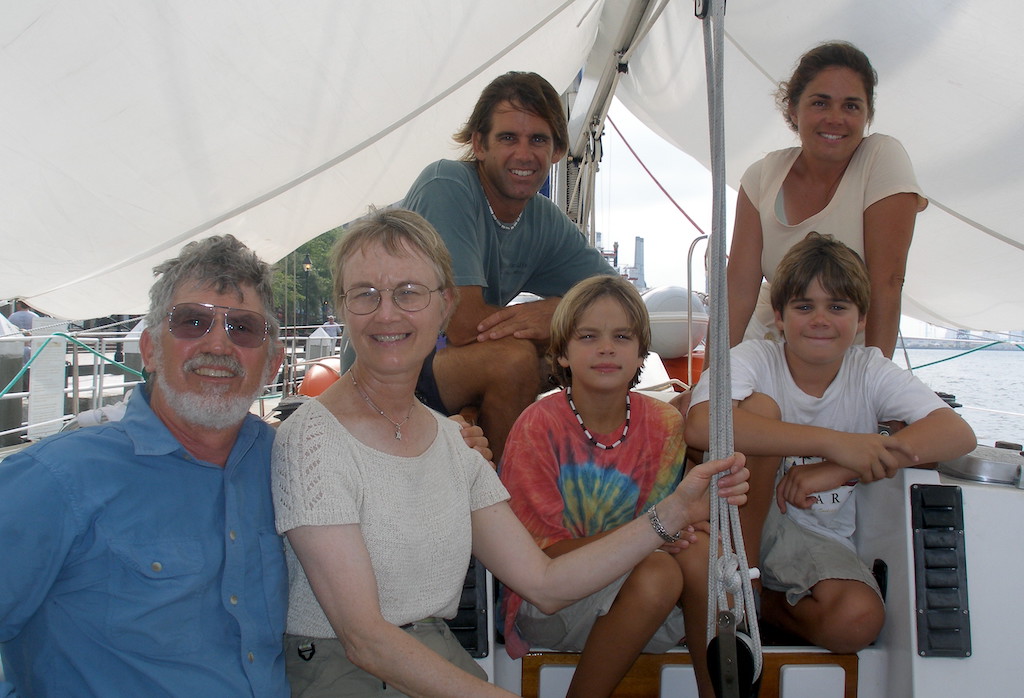Playtime in the tide-free protected waters of Netherland’s inland waterways was over. The proverbial school-yard bell was ringing, calling us back to our main purpose at hand… finding our way into the Baltic Sea. Not only were we entering back into tidal waters, but into a stretch of narrow shallow estuaries running out to the North Sea that required precise planning so that we wouldn’t run aground. We would need to leave on a rising half tide, allowing us enough deep water for the next 6 hours before the water level started falling below half tide again. The winds were howling at our anchorage in the morning behind the Kornwerderzand lock from a low pressure system that blew through overnight, and we briefly considered tucking back into our berth to wait it out for another day. The clutches of a warm bed can be a powerful separator from one’s goals.

Alone inside the big concrete and metal titan of the lock, we came to expect the unexpected and resolved to just deal with it. However much the lock rose or dropped, whatever method of tying off to the wall or deck, and whether we should radio the lock master or remain silent mattered less now. Like a student arguing with their professor over a grade on a paper, we had come to accept the powers that be. In the end, we rose a meter and were tossed out to fend for ourselves on the angry muddy waters of the Wadden Sea, the kind of sea whipped by the winds from their origins over the horizon, churning up the sands of a tightly buoyed channel leading away to the village of Harlingen. The short period waves in a shallow body of water can be so densely packed with energy that it can stop the forward movement of a lightly powered sailboat like ours. At times you feel like you are going vertically up and down waves more than you are going horizontally. The wind direction was just favorable enough for us to sail close hauled down the channel, a channel barely wide enough for two boats to pass, let alone tack to windward. Complicating matters but also putting us in a proper Dutch sailing mood was a procession of beautifully restored flat-bottom boats approaching us, setting out their massive gaff-rigged sails to propel themselves swiftly downwind. A small collection of people were onboard, and it was hard to tell if they were crew or day charter passengers. I counted 18 total ships passing us, striking an image an hour later on the distant horizon that if taken in black and white could have easily found a home in the archives of a maritime museum.


The chart labelled the area just outside the channel as ‘variable depths’, a further reminder for us to not lose our attentiveness. At Harlingen, several sailboats turned into a marina too shallow for us as we continued on, taking a 90 degree turn to port to stay in the deep water. Here the channel widened considerably to accommodate large car ferries running out to the Frisian Islands, the string of Netherland’s barrier islands looking like a police line holding back the rioters of the North Sea. A big tanker and a dredge came into view ahead of us as well. In order to stay clear of this commercial traffic, we walked a tight rope outside the channel buoys but inside a partially submerged dyke meant to keep tidal currents from filling in the channel from the adjacent sand flats. We were already a little anxious about heading back into the ocean, away from the protection of the inland waters; the tight navigation to avoid sand banks all around us that dry up at low tide only added to the stress. Our goal for the night was the island of Terschelling, the place where all of the ferries were running back and forth to. This strategic spot would allow us to tuck in out of the wind and ocean swells for the night, yet put us on the doorstep to our outside passage around the Frisian Islands to Germany. There was no other option for us. Several scenic inside routes were written up in the guide book that combined time in the Wadden Sea and time in manmade canals, but the depths on these routes dropped down to 2m in one section, making it a no go. We also came to realize that with the current moderate weather forecast, we could make a fast passage to the Kiel Canal in two long day hops, whereas the inside passage could take several more days due to lock and bridge opening times.

We left the busy commercial channel near Terschelling and dropped the hook just outside the town harbor, with yet another partial submerged dyke just now starting to break the surface as the tide dropped at dusk. Several sailboats had docked inside the harbor, while we were alone out in the anchorage. The harbor was extremely shallow and narrow at low tide and therefore off-limits to us, yet I looked longingly at them with their ability to get off their boat and stretch their legs and explore the town, while we had a quiet dinner and eyed the waters around us carefully as sand flats appeared close by. The tidal current was ever-present, showing 1.8 knots on the instruments even though we were anchored! Our first hop, a distance of 80 miles to the port of Borkum in Germany, would demand all of our energy tomorrow, forcing us to hit the bunk right after dinner even though the sun was several hours from setting on this evening just one day before the summer solstice.
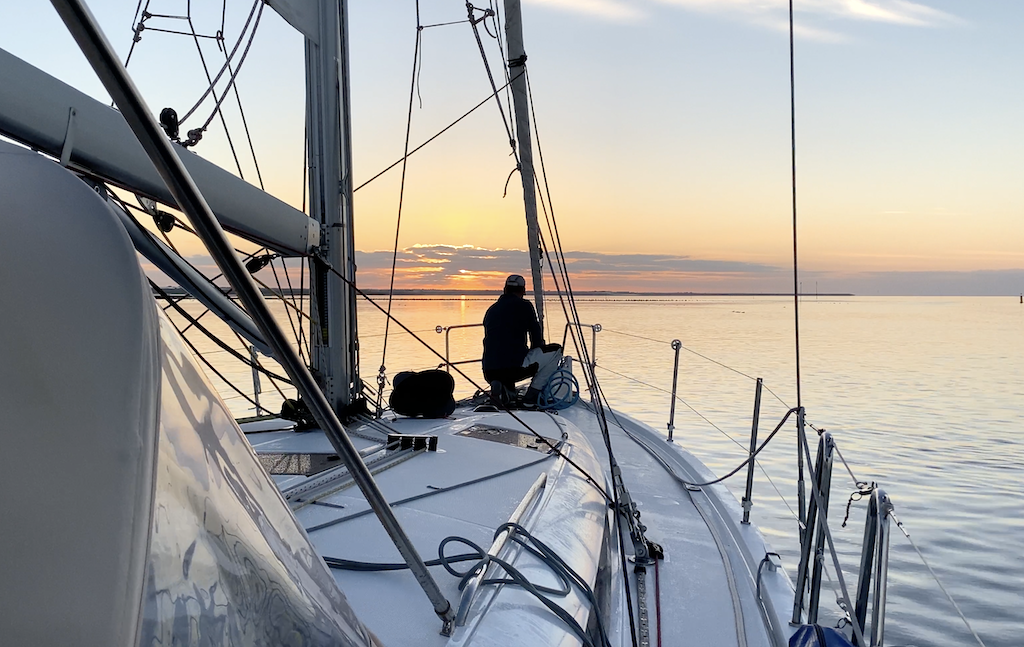

The anchor was up by 5 am in the morning and a similar flow of ebb current was ready to push us out the harbor channel on this windless morning. We had at least two days of calm conditions after very high winds offshore yesterday. Karen and I have no interest in overly dramatic conditions; if the calms today meant we would have to motor the full distance to Borkum, so it would be. There’s plenty to do on a sailboat when you’re not able to sail, including maintenance, meal prep, cleaning, reading, and just simply taking in views that are not as easy to enjoy while you are busy trimming sails. The first attraction came in the form of two interesting wind farm support ships that passed us on their way out to their work sites. The fishing trawler is a ubiquituous sight on most oceans of the world, but these support ships have lots of interesting structures on their deck, and often a helipad to shuttle crew back and forth.

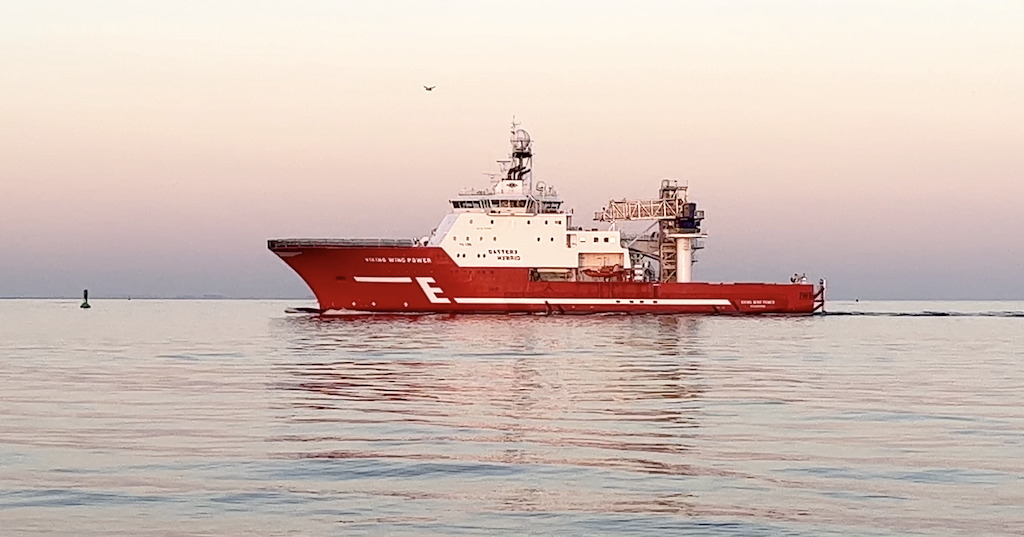
The current continued to flush us out into the North Sea at 2-3 knots. It was as if the Netherlands wanted us gone! But the tricky navigation continued. At one point, we passed over a shoal that was marked as 4-6m deep. The sloppy seas leftover from yesterday’s winds were producing swells of 2m, leaving us little margin for error if the shoal was indeed 4m deep. There were shallows just in shore from us, with waves breaking to mark their exact locations. I really wanted to get through this area and turn east so we can put distance between us and the shallows. From our experience back home in Cape Cod, these sandy shoals can move around from year to year and storm to storm. It is not a place to trust the charted depths, which could have been recorded years or decades ago.
Finally, we were able to turn east and start to tick off the miles to Borkum; and with the current starting to shift in our favor, a reasonable ETA before nightfall encouraged us to push on even if it was under motor. Several other boats were underway, some making futile attempts to sail in the windless but rolly conditions. A sailboat came up behind us in the hazy dawn, but oddly seemed intent on holding their course despite a trajectory that would put them right on top of our stern. They didn’t have AIS so I couldn’t easily track their CPA on screen. It is a mystery to me why some boaters are intent on their heading regardless of whether it sets them dangerously close to a collision. Several years ago, while running under the boot of Italy in similar windless conditions, a large catamaran appeared dead ahead. As I adjusted the autopilot a few degrees at a time away from them, it seemed like they continued to turn towards our bow. Exasperated, when they passed just off our bow, I gave them one of those iconic shoulder shrugs and arms above my head as if to say, “What gives?”, yet they waved whole-heartedly back like an astronaut long overdue for human contact. Odd.
After a tease of wind that had us briefly raising sails, we prepared lines and fenders for our arrival in Borkum. Information was sparse and many years out of date on what we could expect for maritime accommodations. A high speed passenger ferry planing past us indicated some level of tourism on the island, but there certainly was none to be found at the port itself. Apparently there was a small yacht club that accepted visiting boats on a single pontoon, squeezed into a squared off manmade harbor dominated by more support ships for the wind farm industry. Long, two story monochromatic buildings ashore, in logical equally spaced rows, hinted at the makings of a company town. Indeed, we found out later that this was employee housing for wind farm crews. Using our best looking-but-not-looking-like-we-were-looking skills, the accommodations appeared stark, the kind that a young, single person would inhabit before they needed to spruce up the place to impress a potential partner. Beat up old charcoal grills occupied several of the balconies, which indirectly got us in the mood to soothe our souls with a hamburger at a brand-new waterfront cafe, looking like either a perk provided by ‘the company’ or a reflection of healthy wages in the wind farm industry. A gourmet burger, an Aperol Spritz and a witness to the thriving renewable energy industry in the North Sea – had I been in my 20’s – might have led me to eagerly fill out an application.
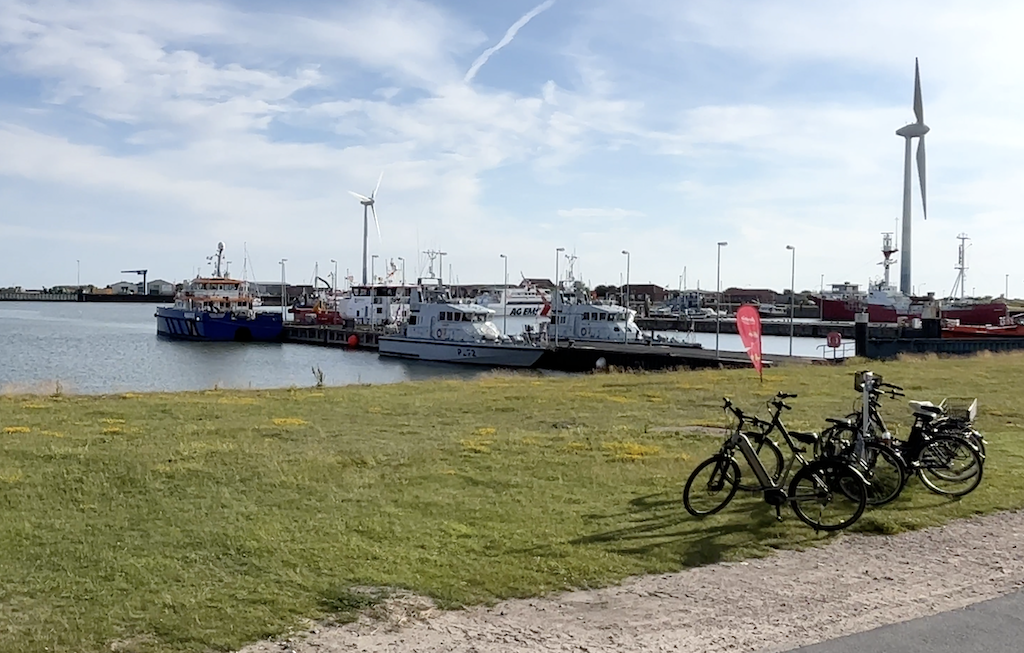

Space was limited on the guest pontoon, and our inner raft-up colleague informed us they were dropping lines at the precise hour of 4:45 am. Ahh, another early morning start, a favor in disguise, as we stared sleepy-eyed at the 90 mile route plotted on the screen to our destination at Cuxhaven. In these coastal zones, most of the wind is driven by solar heating of the surrounding land masses. At 5 am, the sun is up but not enough to drive any air movement, leaving us to motor out of the harbor and optimistically rig the Code 0 for future wind. With a full day of calms yesterday, the seas had settled down nicely. We had picked this two day weather window for its mild conditions, so we had to expect that might necessitate long days of hearing the motor drone on. With some shame, I admit the comfort and predictability of making a passage under motor. You set the throttle at 2000 rpms, lock the heading for the first waypoint in the autopilot, and the computed ETA at your destination is an estimate you can nearly trust for a dinner reservation ashore. But I’ll leave comfort as the mantra for hospice care; for now, we’ll sail as soon as we are gifted with a breath of North Sea breeze.
In the meantime, Mother Nature entertained us with other interesting local phenomenen. On Karen’s watch, she witnessed long brown streaks in suspension just below the water’s surface. Out at sea, in the presence of an occasional passing ship or sailboat, it doesn’t take much imagination to guess the unpleasant origin of brown deposits in the water. Upon closer inspection, the brown streaks were just high concentrations of pollen. But more interesting were the many small polyps of soon-to-be jellyfish, somehow attracted to the pollen-rich water. We could have really benefited from a guest marine biologist on this passage. The job posting is going up immediately to our Careers page!

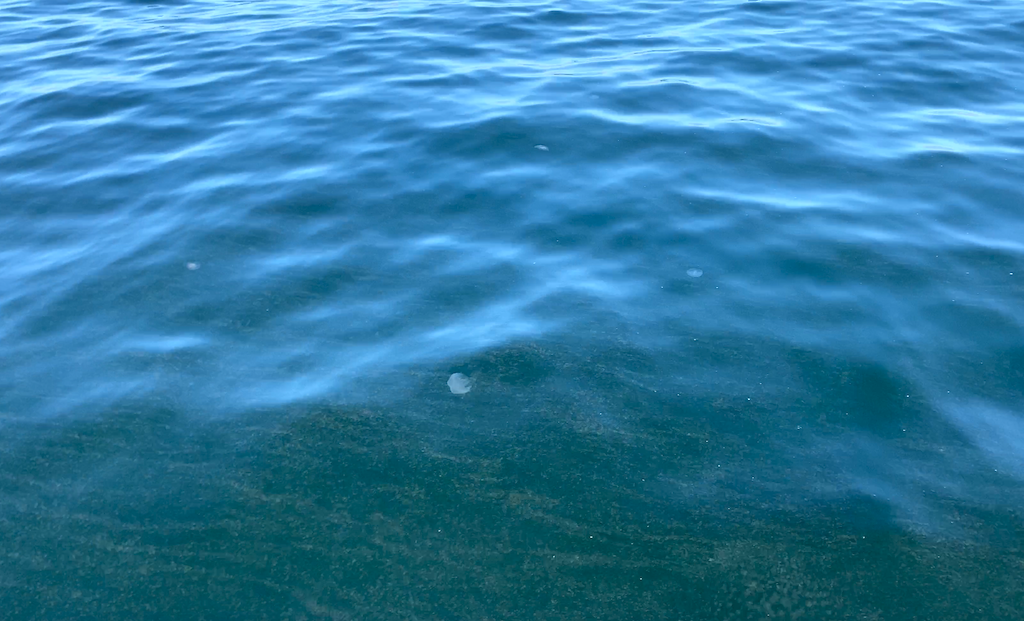
Being in German waters, there were a plethora of strict rules for safety and efficiency beyond the domain of holding tanks. I cataloged 7 VHF channels that we would need to monitor as we approached Cuxhaven and the Kiel Canal. Monitoring these channels was not simply an option, but a requirement. Cargo ships began to appear all around us, as they queued up for berths in the busy nearby port of Bremerhaven as well as Hamburg, at the head of the Elbe River. A sailboat could not merrily cross at right angles to the Traffic Separation Scheme (TSS) that controlled this traffic flow, like we had done back in the English Channel. Stiff fines were rumored to be levied on the spot. You needed to call on the VHF to first obtain permission. And no excuses were allowed for accidentally wandering into the TSS, as small boats like ours were squeezed into a very narrow space outside the TSS but inside of expansive mud flats that dry at low tide. Everywhere one turned on the Elbe, one saw long open spaces of water with the only visible land faraway on the horizon. With so much room, it was hard to understand why they called it a river. But just a boat length or two to our starboard was only 0.5m of water. To avoid further problems with the authorities, we raised an upside-down black cone in the rigging, the day shape to indicate a boat with sails unfurled but under power. Technically, this is a universal navigational rule and I remember it being one of the shapes we memorized for the USCG merchant mariner license exam, but Germany was the first country I’d seen where it was fervently enforced.
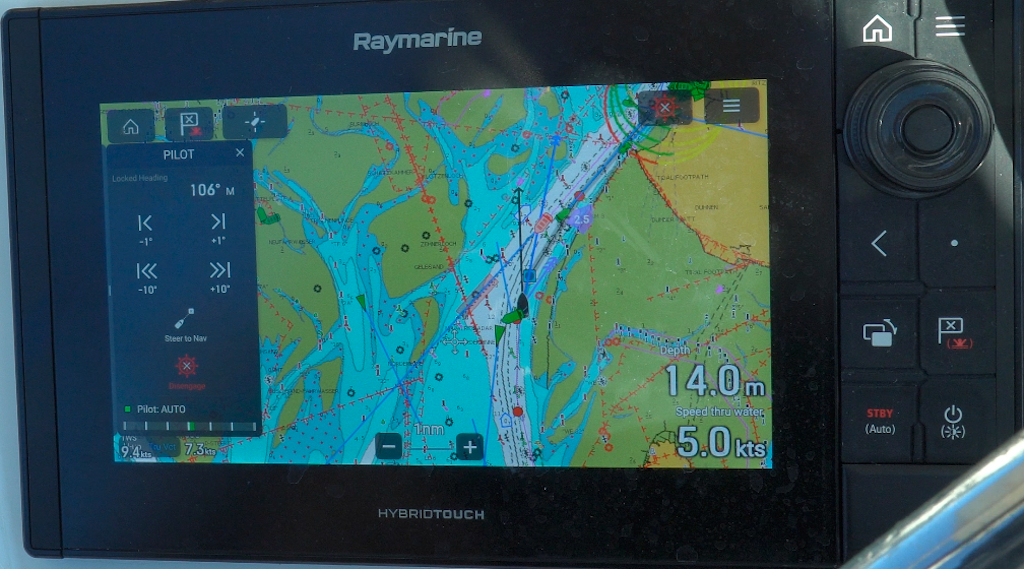
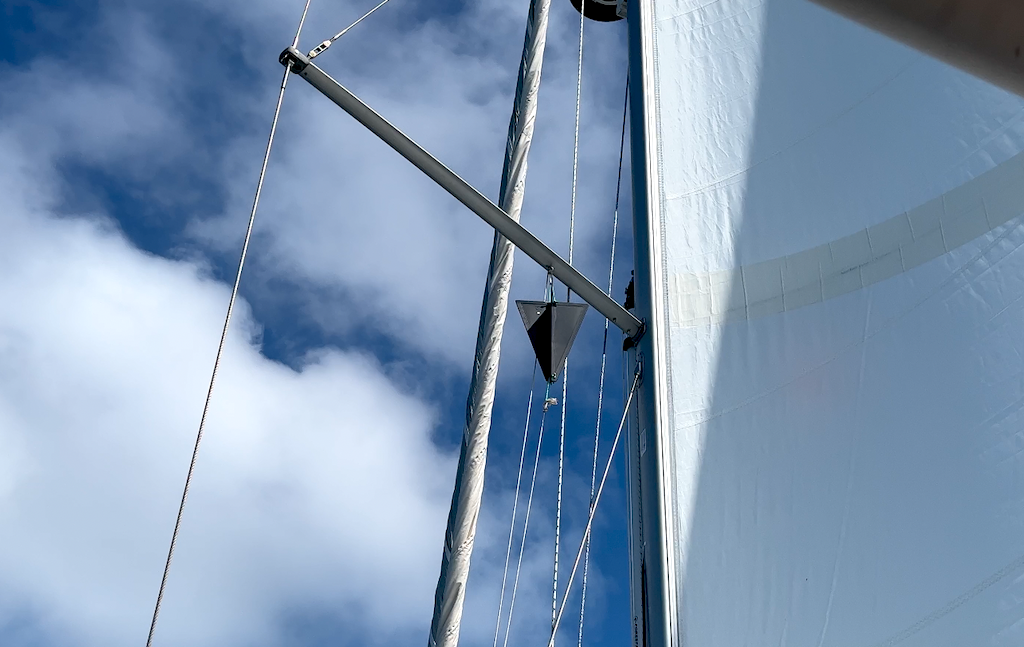
We had timed our arrival at the Elbe River to coincide with the start of the flood tide, an important aid in our passage as we pushed on for the remaining 15 miles to Cuxhaven. The opposite scenario – pounding up the river in purportedly stiff ebb currents, possibly meeting the long ocean swells of the North Sea to form erratic standing waves – seemed like too much last minute drama. Instead, we carefully jumped from buoy to buoy staying just outside the channel and marveling at all the unusual ships passing by. Surprising to us Elbe first-timers were the countless dredges moving about, no doubt here to keep the encroaching sandy shoals at bay. Here, they weren’t messy around with a traditional bucket dredge, using a crane to empty spoils into a nearby barge. Rather, full-sized ships were employed with all manner of pipes and nozzles and rotating drill heads that looked like a Jules Verne’s creation from 20,000 Leagues Under the Sea.

With their slow movement, it is pretty easy to avoid a working dredge, but we did find the VHF handy to contact several containerships to make sure we knew their intentions and confirm their heading from AIS. I must admit, once you get the right radio lingo under your belt, it is a kick to interact with the captains and mates of these ocean-going giants of global trade. It felt a bit like the little kid with his plastic red firefighter’s hat stealing the momentary attention of the tall and dashing firefighters onboard their big shiny fire engines.
The Cuxhaven Yacht Club put the facilities at Borkum to shame, with multiple guest pontoons to accommodate the many boats that converge here, with many like us positioning ourselves for navigation of the Kiel Canal. In the ongoing theme of control and efficiency, visiting boats could only take a dock space marked with a green flag, showing it was available. Once occupied, we were asked to flip the flag to show its red side. The days of free-for-all docking in Greece seemed like a distant memory.

At the Club’s sweeping terrace, with views of the passing ships, the setting sun and a cold beverage in hand, we would have typically rejoiced in the safe passage through historically dangerous waters of the Netherlands and Germany, had it not been for news back stateside from a dear friend. Our fellow companion on many sailing adventures, our neighbor from San Francisco and an overall immensely kind and thoughtful man – Martin – had passed away after several months of sickness. He was survived by his spouse Nancy, an equally gentle soul and fellow sailing mate. Martin, our lives were deeply enriched by your friendship, your stories, and your spirit. May you rest in peace my friend.
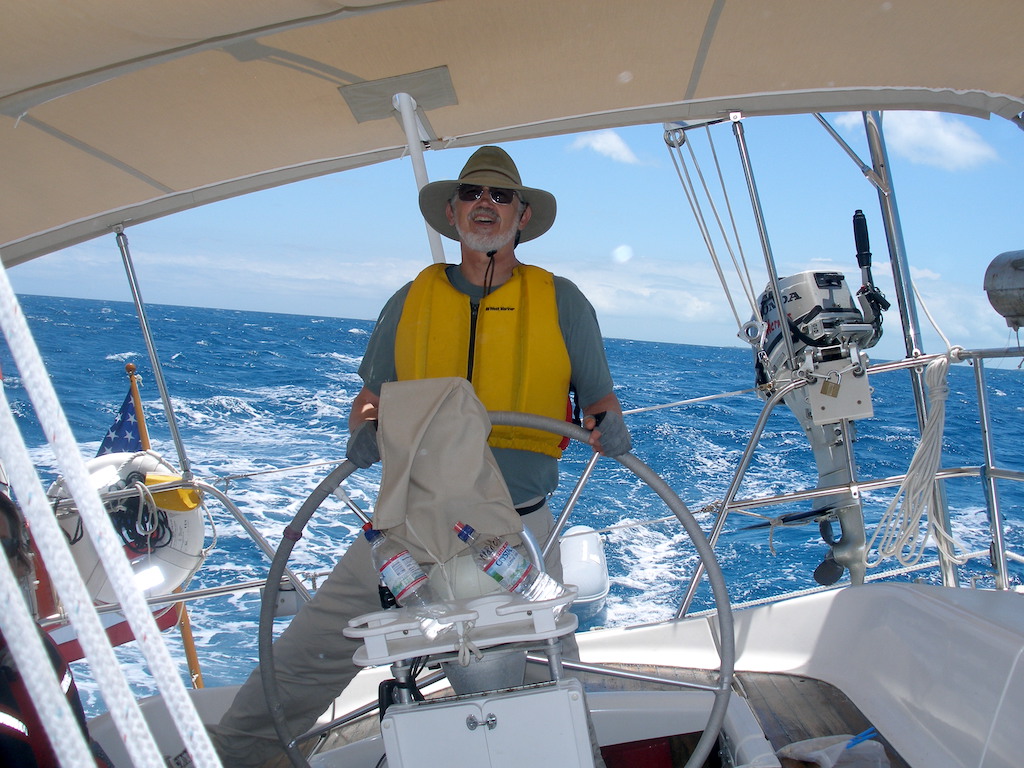
Be sure to also checkout the video content on our LifeFourPointZero YouTube channel. We regularly post updates on our sailing adventures, as well as how to videos on boat repair, sailing techniques, and more!

